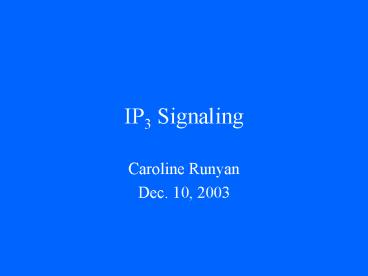IP3 Signaling - PowerPoint PPT Presentation
1 / 14
Title:
IP3 Signaling
Description:
Prevents unactivated-PLC- d -mediated PI Hydrolysis. Molecular Players ... Cleaves PI to produce Inositol Triphosphate (IP3) and Diacylglycerol (DAG) Four main groups: ... – PowerPoint PPT presentation
Number of Views:90
Avg rating:3.0/5.0
Title: IP3 Signaling
1
IP3 Signaling
- Caroline Runyan
- Dec. 10, 2003
2
The Basic Mechanism
3
Molecular PlayersPhosphatidylinositol (PI)
- Membrane Component
- Synthesized in Endoplasmic Reticulum
- Cellular Roles
- PLC Substrate
- Protein Recruitment to the Membrane
- Via pleckstrin homology (PH) domains
- Ex PLC
- Ex Profilin
4
Molecular PlayersProfilin
- Actin-binding protein
- Actin polymerization
- Cell Motility
- While bound to PI
- Sequestered from actin monomers
- Prevents unactivated-PLC- d -mediated PI
Hydrolysis
5
Molecular PlayersPI-Specific Phospholipase C
(PLC)
- Cleaves PI to produce Inositol Triphosphate (IP3)
and Diacylglycerol (DAG) - Four main groups
- a, ß, ?, d
- PLC- ß
- Most abundant in the brain
- Regulated by G-Proteins
- Inhibited by Protein Kinase C (PKC)
- Negative Feedback Inhibition
6
Molecular PlayersPLC-cont.
- PLC- d
- Found throughout the body
- Inhibited by Profilin
- Compete for PI binding
- Inhibited by IP3
- Negative Feedback Mechanism
7
Molecular PlayersIP3
- Known to interact with two types of proteins
- ER-IP3 Receptors
- Inducing release of sequestered Calcium
- Metabolizing Enzymes
- Huge group of diverse proteins, implying
diversity of function
8
Molecular PlayersProtein Kinase C (PKC)
- DAG Product
- Regulated by Ca2, Phosphatidylserine, DAG
- Substrates
- Receptors, Channels, Kinases, Cytoskeletal
proteins, Enzymes - Widespread Effects
9
Molecular PlayersArachidonic Acid (AA)
- DAG Product
- Activates PKC- d, various cationic channels, NMDA
channels
10
Pathway RegulationInteraction Between the Ca2
and PKC Branches
- Synergistic
- Platelets
- Antagonistic
- Neurons
- Independent
- Lymphocytes
- Temporal
- Pancreas
11
Pathway RegulationNegative Feedback Inhibition
- PKC-Mediated
- Inhibits PLC
- Degrades active pathway products
- Desensitization
- Calcium-Mediated
- Interferes with IP3 binding at ER
- Alters PLC-Specificity
12
Pathway RegulationPhospholipid-Mediated
- Phosphatidylcholine (PC)
- After prolonged IP3 pathway stimulation
- PKC activates PC-specific PLC and PLD
- Leads to production of DAG
- No more IP3 production
- Affects membrane fluidity
- cAMP production
13
Clinical Implications
- Schizophrenia
- Abnormal phospholipid composition of the bilayer
and the dopamine hypothesis. - Group I mGlu Rs
- Bipolar Disorder
- Disruption later in pathway, involving PLC and/or
phosphatidylinositol recovery.
14
Summary
- Phosphatidylinositol is cleaved by PLC to form
IP3 and DAG. - IP3 diffusion through the cytosol results in ER
release of Calcium. - DAG activates PKC, which then mediates several
processes throughout the cell. - The pathway is regulated by its own products as
well as surrounding molecules. - Any abnormality in any of the molecules involved
can have devastating effects.

